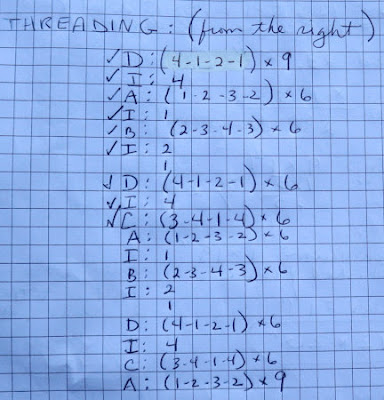Copper = copper sulfate or blue vitriol
Solutions of copper for mordanting or modifying can be made it two ways: with copper sulfate powder or crystals, or with scraps of copper pipe, wire, etc. The directions here are for animal fibers: wool, silk, angora, cashmere, mohair, llama, alpaca, etc.
Mordant made with copper sulfate powder or crystals
The purpose of a mordant is to fix the dye color to the fiber. Copper sulfate is a common one and can be purchased almost anywhere that sells gardening or pond supplies because it's used as an herbicide, fungicide, to control algae in ponds,
and as a soil additive for copper deficient soils. I use it in my
Pat Coleby mineral mix for my goats because it's an essential element for goats. Copper in large amounts is a poison, so one has to use their "smarts" when
handling it.
As with recipes for an
alum mordant, I found a variety of recipes for copper mordant as well. Recommended
amounts range from 2 to 8% copper sulfate of the weight of
goods (WOG).
Jenny Dean uses vinegar
in her copper sulfate recipe. I don't have a very good scale, so I decided to
rely on
Rita Buchanan's quick method measurements:
- 2 tablespoons copper sulfate
- per 1 pound dry goods
 |
| copper sulfate diluted and ready to make the mordant bath |
Procedure
-
Soak the fiber, yarn, or fabric to be dyed in a large pot of clean water
-
Start with thoroughly scoured goods because oils or processing residues
can interfere with the uptake of any mordant.
-
Let soak at least a couple of hours, to ensure thorough wetting for an
even uptake of the mordant.
- Prepare the copper solution
- Dissolve in a small amount of hot water.
- Prepare the mordant solution
-
Dilute the dissolved copper solution in a sufficient amount of water,
typically 4 gallons for a pound of goods. There needs to be enough water
to float the yarn or fiber with plenty of room.
-
Remove the fiber from its soaking pot and add to the mordant pot. Gently
heat to a simmer, and hold at a simmer for about an hour.
- Let cool.
- Remove the fiber and rinse thoroughly (gloves recommended).
- The fiber can be dyed immediately, or dried for future use.
 |
| Wool mordanted with copper has a green tinge |
Re-using the mordant bath
I found instructions for this in Rita Buchanan's
A Dyer's Garden. Because fiber or yarn doesn't absorb all of the chemical from the mordant
bath, it's possible to re-use it by topping it off with additional
chemicals.
-
Use 1/3 the amount of copper sulfate called for in the original recipe
- Follow all the procedure steps above.
After mordanting, the copper solution can also be decanted into a closed
bucket or jar and used again later.
Mordant made with copper pipe and such
I've not tried this yet, but I'm including the instructions for future use!
Copper pipe, wire, or pennies can be used, as long as they are pure copper,
not an alloy.
- Place copper scraps in a wide mouth jar
-
Add water and white vinegar (I've seen 1:1 and 2:1 ratios recommended).
The vinegar is needed to make the copper soluble.
- Lid the jar and let sit for at least a week or two.
- Decant the liquid off as needed and add to the mordant pot.
- Add clean, wet wool
-
Heat to simmering and simmer for about an hour. The fiber should turn pale
green.
- Remove the fiber and rinse thoroughly.
- May be used immediately of dried for later.
An alternative would be to do it the old-fashioned way by doing the dyeing in a copper kettle.
As a modifier
Modifiers are after-dye treatments used to alter the color. They are weaker
solutions than mordant baths, and are a great way to extend the color range of
any given dyestuff. Copper will make colors greener or browner, and generally
improves the fastness of the dye color.
To use immediately:
- Mix 1/4 amount of copper (as for mordant) in hot water
- Remove the fiber from the dyebath and set aside.
- Stir the copper solution into dyebath
- Return the damp fiber to dyebath
- Simmer for 15 to 30 minutes or until the color changes
- Let cool overnight
To make a larger batch ahead of time:
- Mix 1 tablespoon of crystals in 1 quart boiling water.
- Store in an airtight jar.
- This is enough to use for several afterbaths.
Discarding the exhausted mordant or modifier bath
I decanted and saved some of the mordant bath to try as an afterbath in future projects.
Then, because our soil is copper deficient, I was pleased to dilute the remainder and distribute it out on our pasture. Another option is to pour the diluted bath over a gravel driveway.





















